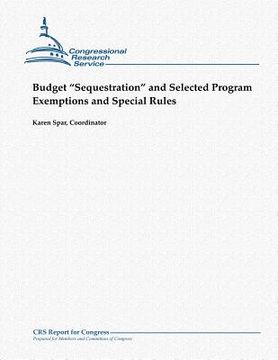Budget "Sequestration" and Selected Program Exemptions and Special Rules (in English)
Synopsis "Budget "Sequestration" and Selected Program Exemptions and Special Rules (in English)"
"Sequestration" is a process of automatic, largely across-the-board spending reductions under which budgetary resources are permanently canceled to enforce certain budget policy goals. It was first authorized by the Balanced Budget and Emergency Deficit Control Act of 1985 (BBEDCA, Title II of P.L. 99-177, commonly known as the Gramm-Rudman-Hollings Act). Sequestration is of current interest because it was included as an enforcement tool in the Budget Control Act of 2011 (BCA, P.L. 112-25). Sequestration can also occur under the Statutory Pay-As-You-Go Act of 2010 (Statutory PAYGO, Title I of P.L. 111-139). In either case, certain programs are exempt from sequestration, and special rules govern the effects of sequestration on others. Most of these provisions are found in Sections 255 and 256 of BBEDCA, as amended. Two provisions were included in the BCA that could result in automatic sequestration: Establishment of discretionary spending limits, or caps, for each of FY2012-FY2021. If Congress appropriates more than allowed under these limits in any given year, sequestration would cancel the excess amount; and Failure of Congress to enact legislation developed by a Joint Select Committee on Deficit Reduction, by January 15, 2012, to reduce the deficit by at least $1.2 trillion. The BCA provided that such failure would trigger a series of automatic spending reductions, including sequestration of mandatory spending in each of FY2013-FY2021, a one-year sequestration of discretionary spending for FY2013, and lower discretionary spending limits for each of FY2014-FY2021. In fact, the Joint Committee did not develop the necessary legislation and Congress did not meet the January 15, 2012, deadline. Thus, the first automatic spending cuts under the BCA are now scheduled to take effect on January 2, 2013. Pursuant to the Sequestration Transparency Act (P.L.112-155), the Administration issued a report on September 14 that previews the estimated impact of that sequestration on discretionary and mandatory spending. Under the Statutory PAYGO Act, sequestration is part of a budget enforcement mechanism that is intended to prevent enactment of mandatory spending and revenue legislation that would increase the federal deficit. This act requires the Office of Management and Budget (OMB) to track costs and savings associated with enacted legislation and to determine at the end of each congressional session if net total costs exceed net total savings. If so, a sequestration will be triggered. If sequestration is triggered-either under the BCA or Statutory PAYGO Act-the exemptions and special rules of Sections 255 and 256 of BBEDCA apply. Most exempt programs are mandatory, and include Social Security and Medicaid; refundable tax credits to individuals; and low-income programs such as the Children's Health Insurance Program, Supplemental Nutrition Assistance Program, Temporary Assistance for Needy Families, and Supplemental Security Income. Some discretionary programs also are exempt, notably all programs administered by the Department of Veterans Affairs. Also, subject to notification of Congress by the President, military personnel accounts may either be exempt or reduced by a lower percentage. Special rules also apply to several, primarily mandatory, programs. For example, under Section 256 of BBEDCA, Medicare may not be sequestered by more than 4%. However, under a sequester triggered by the BCA, reduction of Medicare is further limited to no more than 2%.

